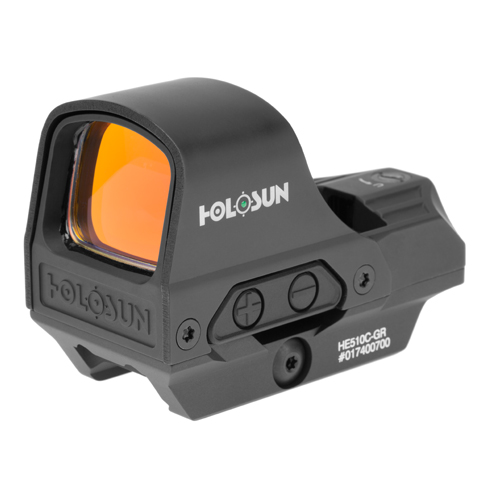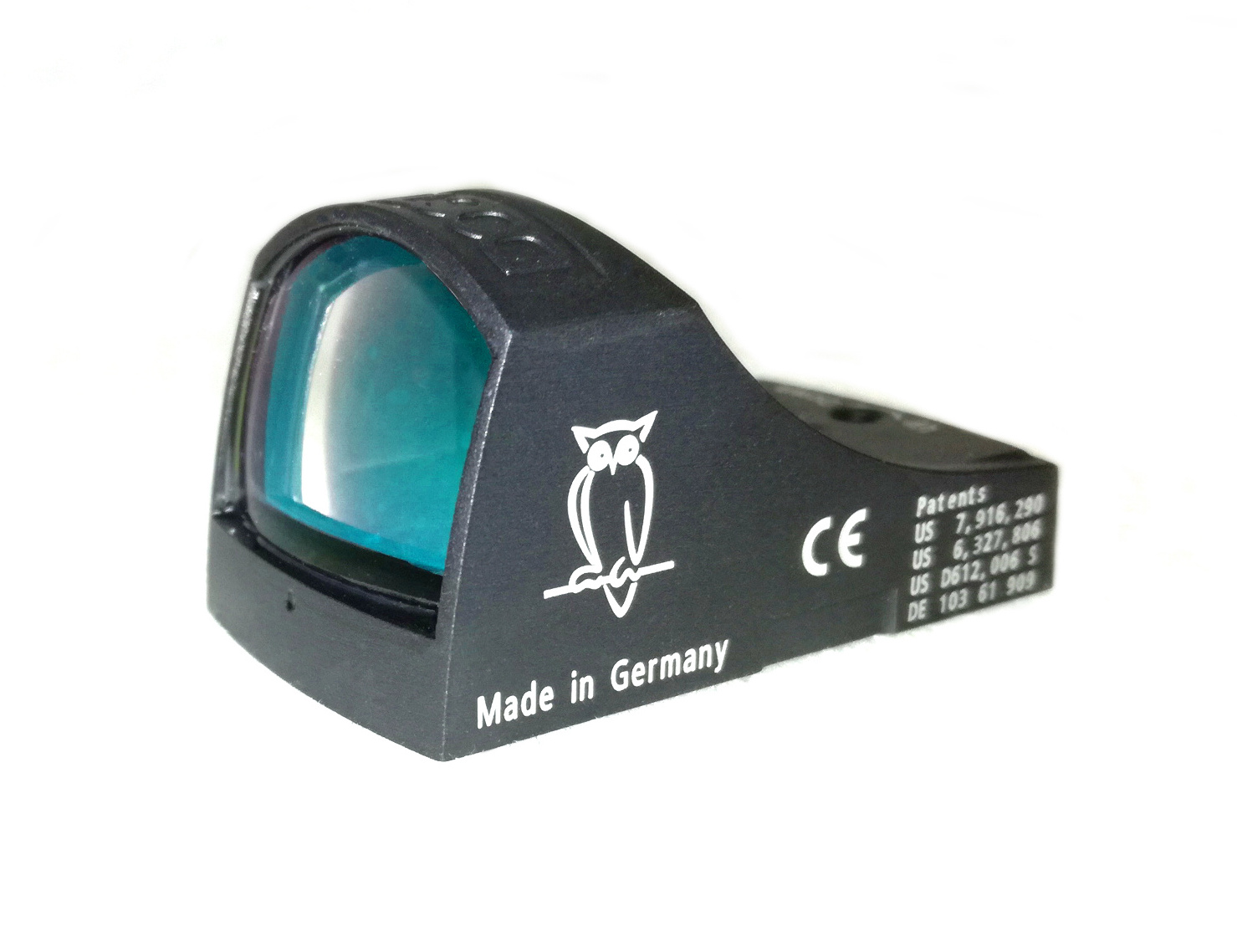My last two posts for the SDCGO blog have covered the basics of magnified scopes, helping the formerly uninitiated to understand all those facts and figures on the side of the box. Now, let’s take a break from that and dig into red dot sights.
First of all, “red dot” is something of a misnomer. When people use that term, they’re often collectively referring to two substantially different classes of optical sight: reflex and holographic. At the gun store, customers would sometimes ask me the difference between the two, and I would dutifully provide a detailed technical explanation of how each type of optical sight worked. I would then inevitably be met with a blank stare. In this blog post, I’ll keep the technical explanations as minimal as possible, so don’t worry if you got a D in high school physics.
Shooting Experience
The first thing you need to know as a shooter is that both reflex sights and holographic sights project a virtual reticle at infinity, which is just a fancy way of saying that the reticle (dot, circle, chevron, whatever) appears overlaid on whatever you’re looking at, rather than an image on the glass. This in turn means that with either type of optic, you should shoot with both eyes open and your eyes focused on the target, not the sight. Barring any neurological or ocular problems, your brain will overlay the reticle your dominant eye sees with the unobstructed view from your non-dominant eye, causing the optic’s housing to almost disappear.
Although reflex and holographic sights offer nearly indistinguishable shooting experiences, the different technologies they use affect the optics’ other characteristics. Which, then, should you pick?
Reflex Sights
Almost all of the non-magnified electro-optics you see for sale are reflex sights. A reflex sight uses a light source (known as the emitter) and a partially reflective lens (like one-way glass) to create the reticle. This technology is very simple and easy to replicate, meaning there are countless companies selling reflex sights, some for very low prices. These optics also come in many shapes and sizes:
Trijicon offers a few models illuminated by ambient light and tritium vials, but almost all reflex sights on the market use tiny LEDs. This means that they are very energy-efficient, often having battery lives of at least 50,000 hours (5.7 years) on a low setting. Additionally, some models come with “shake-awake” or motion activation, meaning the optic will turn itself off if left stationary for a few minutes, further preserving the battery.
Reflex sights have a few distinct disadvantages for civilian shooters. First, because of the way the reticle is generated, astigmatic shooters will see a blur or a streak instead of a clear dot. Second, because the lens must be partially reflective, all reflex sights are tinted to some degree, which may be distracting. They also don’t perform as well under night vision for the same reason, but if you’re shooting under night vision, you most likely already have your rifle set up for that and you definitely don’t need to be reading this blog post.
Open vs. Closed Emitter Pistol Sights
If you make the mistake of reading comment sections and gun forums, which for the record I absolutely do not recommend you do, you’ll find people arguing about this. “Open emitter” means the sight only has a front lens, meaning emitter is open to the outside; “closed emitter” means the optic is a fully enclosed tube.
The contention is that open-emitter designs are more prone to moisture and dust accumulation on the emitter and lens, which is true, but I’m honestly not sure if it makes enough of a difference to cause a problem in practical use given that that stuff can be cleared out with a finger. Closed-emitter red dots should theoretically be more robust and reliable, so they’re a better choice for rifles and shotguns that will be used in adverse conditions, and they’re probably better for duty handguns, but a concealed carry handgun should be sufficiently protected from the elements that a more conventional open-emitter design (in the style of the Trijicon RMR) that ingress of debris may be less of a problem.
Holographic Sights
As of the time of writing (August 2024), there are two companies producing holographic sights: EOTech and Vortex. The former dominates the market, whereas the latter only sells one model, the Razor AMG UH-1. A holographic sight works by using a laser and mirrors to project an image from holographic film onto a flat pane of glass. This system is much heavier, bulkier, far more expensive to manufacture, and the laser eats through batteries in record time. Why, then, do people use holographic sights?
For a civilian shooter who doesn’t use night vision, a holographic sight offers two main advantages. First, because the reticle is a projected image rather than a direct reflection of a light source, a shooter with even a severe astigmatism will still see it clearly, unlike with a reflex sight. Second, holographic sights work better with magnifiers. Some shooters opt to set up their rifles with a reflex or holographic sight and a flip-over magnifier, a combination which allows the shooter to easily transition between long-range and short-range shooting. When viewed through a magnifier, a reflex sight’s reticle is magnified along with the background image, making both appear larger to the shooter. A holographic sight’s reticle does not appear magnified, meaning the reticle actually becomes more precise. The background image appears larger but the reticle does not.
Reticle Color
Most reflex and holographic sights come with red reticles. Green has become somewhat popular in recent years with improvements in green LED efficiency; the cone cells in the human retina are more sensitive overall to wavelengths near the middle of the visible spectrum, meaning a green dot of the same actual intensity will appear brighter visually. Anecdotally, red reticles often appear sharper, but it isn’t enough of a difference to make green dot sights a bad option.
Stay away from optics that offer blue reticles or the ability to switch colors. In my experience, those dubious “features” are gimmicks present on crappy no-name sights from Amazon or Walmart which don’t hold zero and won’t stand up to recoil. Your $20 is better spent on snacks, because at least you’ll derive some enjoyment from those, unlike garbage optics.
Conclusion
As long as you buy from a trusted brand, a reflex sight can be an inexpensive upgrade for an iron-sighted rifle or shotgun I like the Holosun 403 and 503 series and the SIG Sauer Romeo4 and Romeo5 (which are made with the same parts as Holosuns), but if you have lots of money to throw around, Aimpoint is unbeatable for quality, clarity, and durability. Holographic sights are more specialized, but they excel in the specific use cases in which they are advantaged over reflex sights. Whichever one you buy, the most important thing is to regularly train with it to build and maintain proficiency. It doesn’t matter how fancy your optics stack is if you can’t shoot with it.









Comments